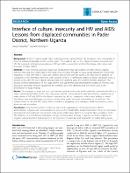Interface of culture, insecurity and HIV and AIDS: lessons from displaced communities in Pader district, northern Uganda
Abstract
Northern Uganda unlike other rural regions has registered high HIV prevalence rates comparable to
those of urbanized Kampala and the central region. This could be due to the linkages of culture, insecurity and
HIV. We explored community perceptions of HIV and AIDS as a problem and its inter-linkage with culture and
insecurity in Pader District.
Methods: A cross sectional qualitative study was conducted in four sub-counties of Pader District, Uganda
between May and June 2008. Data for the study were collected through 12 focus group discussions (FGDs) held
separately; 2 FGDs with men, 6 FGDs with women, and 4 FGDs with the youth (2 for each sex). In addition we
conducted 15 key informant interviews with; 3 health workers, 4 community leaders at village and parish levels, 3
persons living with HIV and 5 district officials. Data were analysed using the content thematic approach. This
process involved identification of the study themes and sub-themes following multiple reading of interview and
discussion transcripts. Relevant quotations per thematic area were identified and have been used in the
presentation of study findings.
Results: The struggles to meet the basic and survival needs by individuals and households overshadowed HIV as a
major community problem. Conflict and risky sexual related cultural practices were perceived by communities as
major drivers of HIV and AIDS in the district. Insecurity had led to congestion in the camps leading to moral
decadence, rape and defilement, prostitution and poverty which increased vulnerability to HIV infection. The
cultural drivers of HIV and AIDS were; widow inheritance, polygamy, early marriages, family expectations, silence
about sex and alcoholism.
Conclusions: Development partners including civil society organisations, central government, district
administration, religious and cultural leaders as well as other stakeholders should mainstream HIV in all community
development and livelihood interventions in the post conflict Pader district to curtail the likely escalation of the
HIV epidemic. A comprehensive behaviour change communication strategy is urgently needed to address the
negative cultural practices. Real progress in the region lies in advocacy and negotiation to realise lasting peace.
URI
http://www.conflictandhealth.com/content/4/1/18https://kyuspace.kyu.ac.ug/xmlui/handle/20.500.12504/320

